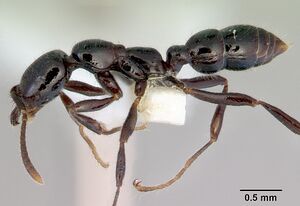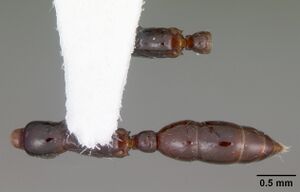Onychomyrmex hedleyi
| Onychomyrmex hedleyi | |
|---|---|

| |
| Scientific classification | |
| Kingdom: | Animalia |
| Phylum: | Arthropoda |
| Class: | Insecta |
| Order: | Hymenoptera |
| Family: | Formicidae |
| Subfamily: | Amblyoponinae |
| Tribe: | Amblyoponini |
| Genus: | Onychomyrmex |
| Species: | O. hedleyi |
| Binomial name | |
| Onychomyrmex hedleyi Emery, 1895 | |
| At a Glance | • Ergatoid queen |
I took two small companies of this ant, unaccompanied by larvae or females, Oct. 24 and 28, evidently on foraging expeditions in the heart of rotten logs. One of the companies comprised a dozen, the other about two dozen workers. Later Mr. Dodd sent me eight workers which he had taken in the same locality. The ants moved rather slowly and were easily captured. (Wheeler 1916)
Identification
Distribution
Latitudinal Distribution Pattern
Latitudinal Range: -15.83° to -20.578928°.
| North Temperate |
North Subtropical |
Tropical | South Subtropical |
South Temperate |
- Source: AntMaps
Distribution based on Regional Taxon Lists
Australasian Region: Australia (type locality).
Distribution based on AntMaps
Distribution based on AntWeb specimens
Check data from AntWeb
Countries Occupied
| Number of countries occupied by this species based on AntWiki Regional Taxon Lists. In general, fewer countries occupied indicates a narrower range, while more countries indicates a more widespread species. |

|
Estimated Abundance
| Relative abundance based on number of AntMaps records per species (this species within the purple bar). Fewer records (to the left) indicates a less abundant/encountered species while more records (to the right) indicates more abundant/encountered species. |

|
Biology
Workers of O. hedleyi did not dismember prey but recruited nestmates to conduct group retrieval. If the prey was too large or too heavy to retrieve, the entire colony moved from the bivouac site to the prey site (Miyata et al. 2009). Colonies were nomadic and the relocation distance was up to 150 cm (mean +/- SD, 74.4 +/- 45.0 cm). Retinues guarded a queen who moved to a new bivouac site in the early phase of relocation . Colony size was 850 +/- 341 workers (Miyata et al. 2003).
Castes
Data about ergatoid queens are given in Miyata et al. (2003)
Worker
Images from AntWeb
   
| |
| Worker. Specimen code casent0102176. Photographer April Nobile, uploaded by California Academy of Sciences. | Owned by NHMUK, London, UK. |
   
| |
| Worker. Specimen code casent0102178. Photographer April Nobile, uploaded by California Academy of Sciences. | Owned by NHMUK, London, UK. |
   
| |
| Worker. Specimen code casent0172260. Photographer April Nobile, uploaded by California Academy of Sciences. | Owned by ANIC, Canberra, Australia. |
   
| |
| Worker. Specimen code casent0003164. Photographer April Nobile, uploaded by California Academy of Sciences. | Owned by CAS, San Francisco, CA, USA. |
    
| |
| Worker. Specimen code casent0102177. Photographer April Nobile, uploaded by California Academy of Sciences. | Owned by NHMUK, London, UK. |
Nomenclature
The following information is derived from Barry Bolton's Online Catalogue of the Ants of the World.
- hedleyi. Onychomyrmex hedleyi Emery, 1895g: 350, fig. 2 (w.) AUSTRALIA (Queensland).
- Type-material: syntype workers (number not stated).
- Type-locality: Australia: Queensland, Mt Bellenden Ker (Podenzana).
- Type-depositories: ANIC, MSNG, NHMB.
- Forel, 1915b: 4 (m.); Wheeler, G.C. & Wheeler, J. 1964b: 454 (l.).
- Status as species: Emery, 1911d: 97; Forel, 1915b: 3; Wheeler, W.M. 1916a: 50 (redescription); Brown, 1960a: 181, 223; Taylor & Brown, 1985: 37; Taylor, 1987a: 50; Bolton, 1995b: 300.
- Distribution: Australia.
Unless otherwise noted the text for the remainder of this section is reported from the publication that includes the original description.
Type Material
Syntype workers from Mt. Bellenden Ker, Queensland (3 in Australian National Insect Collection, 2 pins in Museo Civico di Storia Naturale, Genoa, 1 worker in Naturhistorisches Museum, Basel).
- Syntype, 3 workers, Mt. Bellenden Ker, Queensland, Australia, Australian National Insect Collection.
- Syntype, workers on 2 pins, Mt. Bellenden Ker, Queensland, Australia, Museo Civico di Storia Naturale, Genoa.
- Syntype, 1 worker, Mt. Bellenden Ker, Queensland, Australia, Naturhistorisches Museum, Basel.
Description
Worker
Wheeler (1916) - Length 3.5-4 mm.
Head about 1 1/4 times as long as broad, subrectangular, a little broader in front than behind, with straight sides and posterior border and rounded posterior corners. Clypeus with the anterior border slightly flattened, arcuately rounded in the middle, sinuate at the sides, its edge beset with about 20 minute, regular teeth. Eyes with about 6-8 minute ommatidia, situated 3/5 the length of the head from the anterior margin. Mandibles with long, abruptly incurved apical tooth and seven basal teeth of different sizes, the two in the middle of the series largest and directed backward. Antennae slender, scapes fully 4/5 as long as the head, first and last funicular joints twice as long as broad, remaining joints about l ½ times as long as broad. Thoracic sutures all strongly impressed; pronotum convex above, especially in front, with convex sides, a little longer than broad; mesonotum nearly twice as broad as long; epinotum longer and narrower than the pronotum, longer than broad, with feebly convex sides and separated in dorsal view from the pronotum by a pronounced impression on each side. In profile the thorax is distinctly impressed at the mesonotum, the base of the epinotum is nearly twice as long as the straight declivity into which it passes through an obtuse angle. Node of petiole in profile with rather straight anterior slope and convex summit, slightly concave at the posterior border; from above the node is as long as broad, rounded in front, with straight posterior border; ventral projection long and blunt, compressed and somewhat translucent. Postpetiole as long as broad, first gastric segment a little longer than the postpetiole. Legs slender.
Very smooth and shining; mandibles, clypeus, and cheeks subopaque, the mandibles finely striated, the clypeus and cheeks finely rugulose-punctate. Body with fine,' sparse, piligerous punctures, which are most numerous on the head, especially on its sides.
Hairs delicate, pale yellowish, short, suberect, covering not only the whole body, legs, and antennal scapes but also the funiculi; somewhat longer and sparser on the thorax, abdomen, and legs than on the head and antennae.
Black; thoracic sutures, sides and terminal segments of abdomen, clypeus, cheeks, and anterior portion of gula reddish castaneous, mandibles, except their teeth, antennae, and legs paler, brownish red, middle portions of femora and tibiae more or less infuscated.
References
- Billen, J., Khalife, A., Ito, F., Anh, N.D., Esteves, F.A. 2021. The basitarsal sulcus gland, a novel exocrine structure in ants. Arthropod Structure, Development 61, 101041 (doi:10.1016/j.asd.2021.101041).
- Emery, C. (1895) Descriptions de quelques fourmis nouvelles d'Australie. Annales de la Société Entomologique de Belgique. 39:345–358. (page 350, fig. 2 worker described)
- Forel, A. 1915b. Results of Dr. E. Mjöbergs Swedish Scientific Expeditions to Australia 1910-13. 2. Ameisen. Ark. Zool. 9(1 16: 1-119 (page 4, male described)
- Jansen, G., Savolainen, R. 2010. Molecular phylogeny of the ant tribe Myrmicini (Hymenoptera: Formicidae). Zoological Journal of the Linnean Society 160(3), 482–495 (doi:10.1111/j.1096-3642.2009.00604.x).
- Miyata, H.; Hirata, M.; Azuma, N; Murakami, T; Higashi, S. 2009. Army ant behaviour in the poneromorph hunting ant Onychomyrmex hedleyi Emery (Hymenoptera: Formicidae; Amblyoponinae). Australian Journal of Entomology 48, 47–52
- Miyata, H.; Shimamura, T.; Hirosawa, H.; Higashi, S. 2003. Morphology and phenology of the primitive ponerine army ant Onychomyrmex hedleyi (Hymenoptera: Formicidae: Ponerinae) in a highland rainforest of Australia. J. Nat. Hist. 37: 115-125 (page 115, Morphology)
- Wheeler, G. C.; Wheeler, J. 1964b. The ant larvae of the subfamily Ponerinae: supplement. Ann. Entomol. Soc. Am. 57: 443-462 (page 454, larva described)
- Wheeler, W. M. 1916. The Australian ants of the genus Onychomyrmex. Bulletin of the Museum of Comparative Zoology 60: 45-54 (page 50, see also)
References based on Global Ant Biodiversity Informatics
- Brown W. L., Jr. 1960. Contributions toward a reclassification of the Formicidae. III. Tribe Amblyoponini (Hymenoptera). Bulletin of the Museum of Comparative Zoology 122: 143-230.
- King J. R., A. N. Andersen, and A. D. Cutter. 1998. Ants as bioindicators of habitat disturbance: validation of the functional goup model for Australi's humid tropics. Biodiversity and Conservation 7: 1627-1638.
- Taylor R. W. 1987. A checklist of the ants of Australia, New Caledonia and New Zealand (Hymenoptera: Formicidae). CSIRO (Commonwealth Scientific and Industrial Research Organization) Division of Entomology Report 41: 1-92.
- Wheeler W. M. 1916. The Australian ants of the genus Onychomyrmex. Bulletin of the Museum of Comparative Zoology 60: 45-54.

